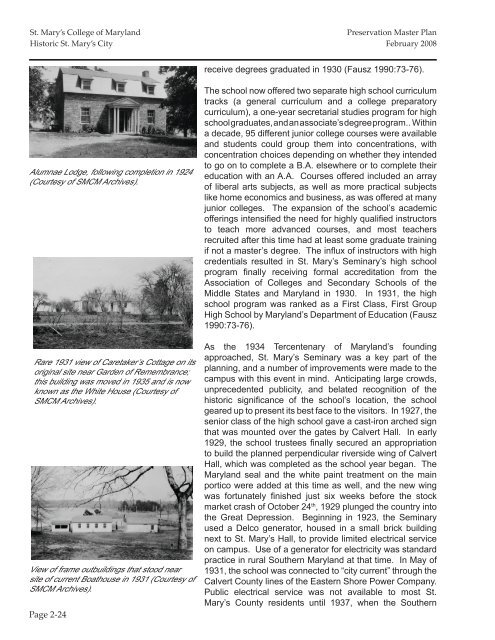St. Mary's College of Maryland Preservation Master Plan
St. Mary's College of Maryland Preservation Master Plan
St. Mary's College of Maryland Preservation Master Plan
- No tags were found...
Create successful ePaper yourself
Turn your PDF publications into a flip-book with our unique Google optimized e-Paper software.
<strong>St</strong>. Mary’s <strong>College</strong> <strong>of</strong> <strong>Maryland</strong><strong>Preservation</strong> <strong>Master</strong> <strong>Plan</strong>Historic <strong>St</strong>. Mary’s City February 2008receive degrees graduated in 1930 (Fausz 1990:73-76).Alumnae Lodge, following completion in 1924(Courtesy <strong>of</strong> SMCM Archives).The school now <strong>of</strong>fered two separate high school curriculumtracks (a general curriculum and a college preparatorycurriculum), a one-year secretarial studies program for highschool graduates, and an associate’s degree program.. Withina decade, 95 different junior college courses were availableand students could group them into concentrations, withconcentration choices depending on whether they intendedto go on to complete a B.A. elsewhere or to complete theireducation with an A.A. Courses <strong>of</strong>fered included an array<strong>of</strong> liberal arts subjects, as well as more practical subjectslike home economics and business, as was <strong>of</strong>fered at manyjunior colleges. The expansion <strong>of</strong> the school’s academic<strong>of</strong>ferings intensified the need for highly qualified instructorsto teach more advanced courses, and most teachersrecruited after this time had at least some graduate trainingif not a master’s degree. The influx <strong>of</strong> instructors with highcredentials resulted in <strong>St</strong>. Mary’s Seminary’s high schoolprogram finally receiving formal accreditation from theAssociation <strong>of</strong> <strong>College</strong>s and Secondary Schools <strong>of</strong> theMiddle <strong>St</strong>ates and <strong>Maryland</strong> in 1930. In 1931, the highschool program was ranked as a First Class, First GroupHigh School by <strong>Maryland</strong>’s Department <strong>of</strong> Education (Fausz1990:73-76).Rare 1931 view <strong>of</strong> Caretaker’s Cottage on itsoriginal site near Garden <strong>of</strong> Remembrance;this building was moved in 1935 and is nowknown as the White House (Courtesy <strong>of</strong>SMCM Archives).View <strong>of</strong> frame outbuildings that stood nearsite <strong>of</strong> current Boathouse in 1931 (Courtesy <strong>of</strong>SMCM Archives).Page 2-24As the 1934 Tercentenary <strong>of</strong> <strong>Maryland</strong>’s foundingapproached, <strong>St</strong>. Mary’s Seminary was a key part <strong>of</strong> theplanning, and a number <strong>of</strong> improvements were made to thecampus with this event in mind. Anticipating large crowds,unprecedented publicity, and belated recognition <strong>of</strong> thehistoric significance <strong>of</strong> the school’s location, the schoolgeared up to present its best face to the visitors. In 1927, thesenior class <strong>of</strong> the high school gave a cast-iron arched signthat was mounted over the gates by Calvert Hall. In early1929, the school trustees finally secured an appropriationto build the planned perpendicular riverside wing <strong>of</strong> CalvertHall, which was completed as the school year began. The<strong>Maryland</strong> seal and the white paint treatment on the mainportico were added at this time as well, and the new wingwas fortunately finished just six weeks before the stockmarket crash <strong>of</strong> October 24 th , 1929 plunged the country intothe Great Depression. Beginning in 1923, the Seminaryused a Delco generator, housed in a small brick buildingnext to <strong>St</strong>. Mary’s Hall, to provide limited electrical serviceon campus. Use <strong>of</strong> a generator for electricity was standardpractice in rural Southern <strong>Maryland</strong> at that time. In May <strong>of</strong>1931, the school was connected to “city current” through theCalvert County lines <strong>of</strong> the Eastern Shore Power Company.Public electrical service was not available to most <strong>St</strong>.Mary’s County residents until 1937, when the Southern
















